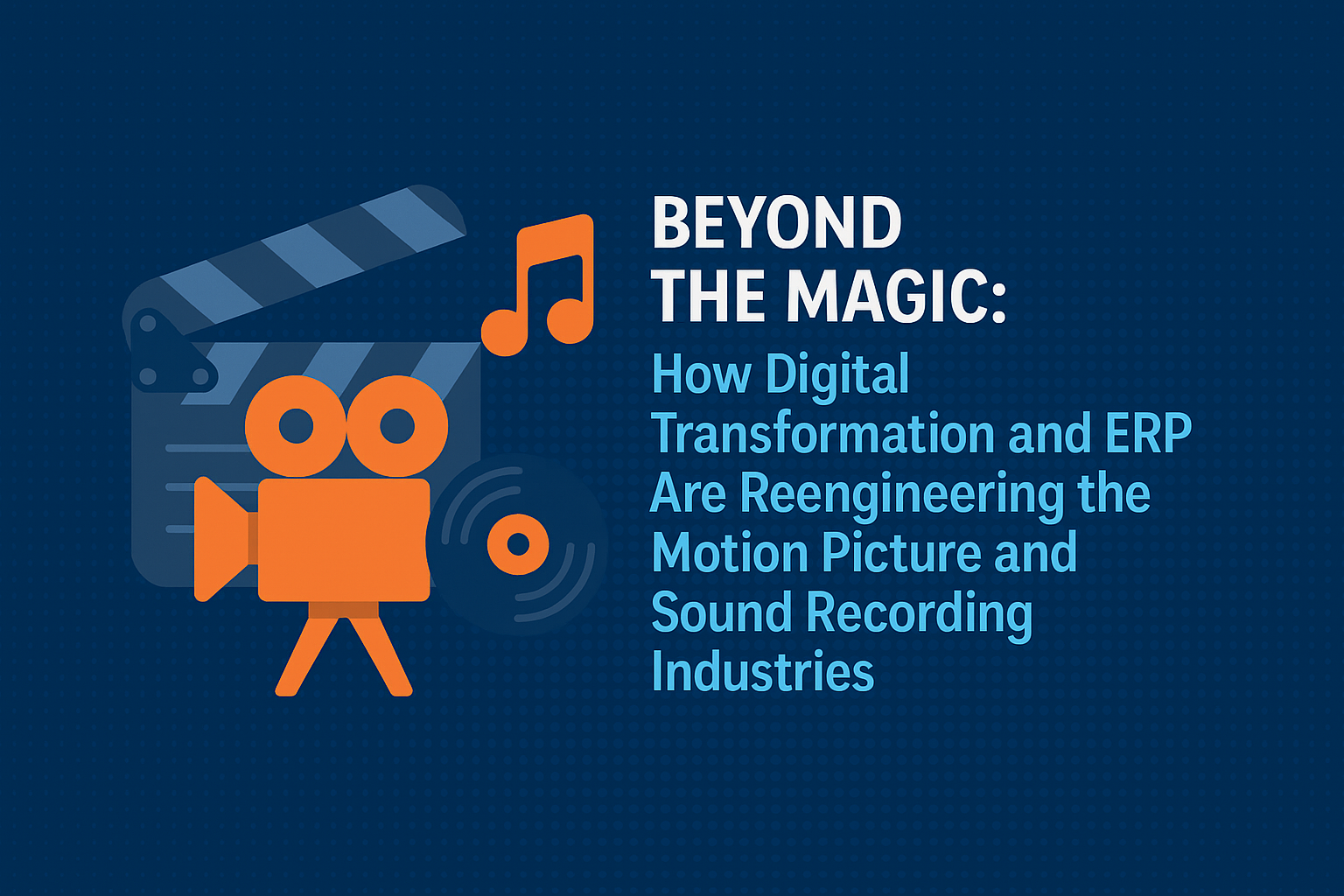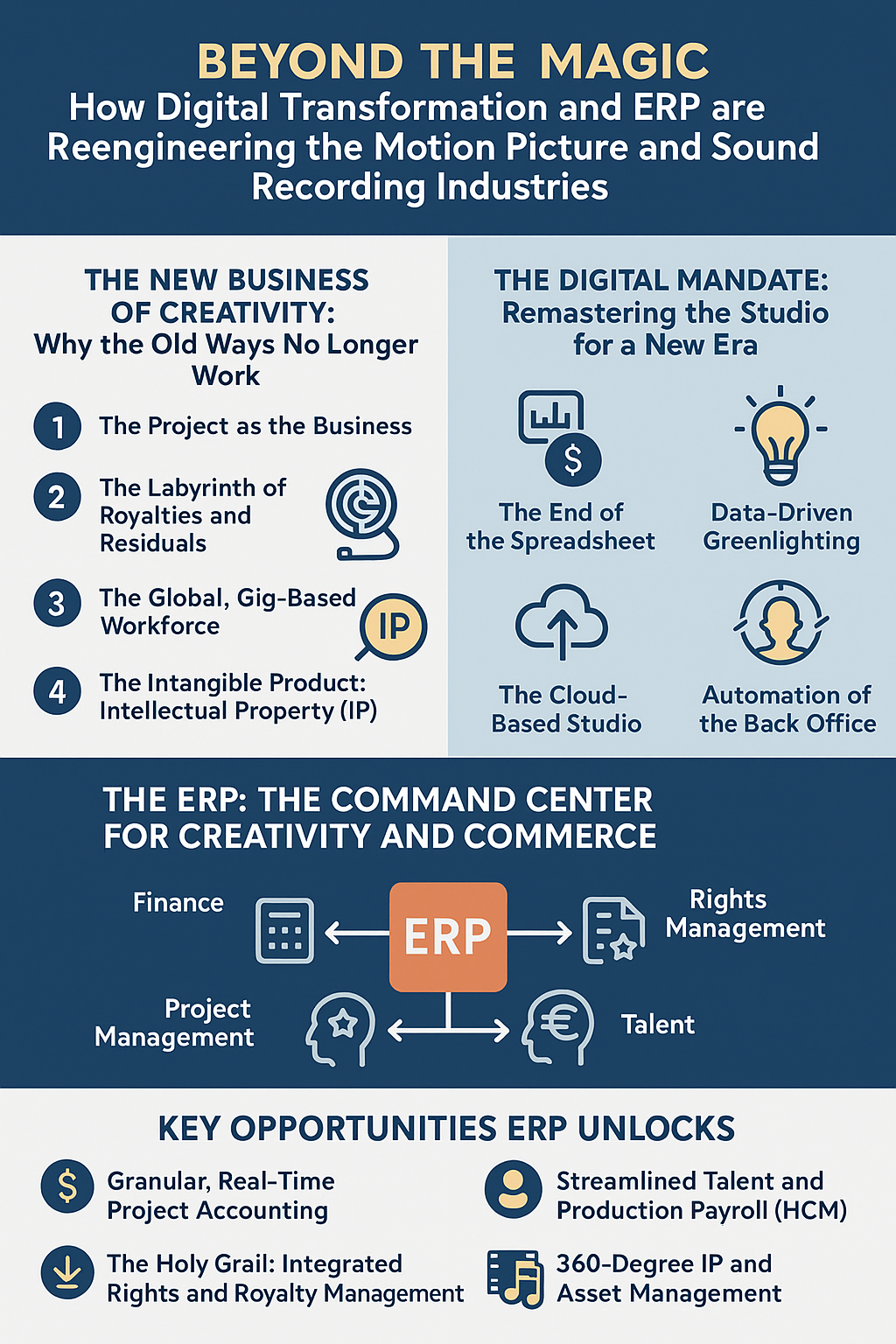Beyond the Magic: How Digital Transformation and ERP are Reengineering the Motion Picture and Sound Recording Industries
2025-10-22 · By Anil Kancharla · 8 min read
❤️ 0 Likes · 👁️ 0 Views
 AI-generated image for illustration purposes only.
AI-generated image for illustration purposes only.
Beyond the Magic: How Digital Transformation and ERP are Reengineering the Motion Picture and Sound Recording Industries
 AI-generated image for illustration purposes only.
AI-generated image for illustration purposes only.
The motion picture and sound recording industries are built on magic. They are the dream factories of our culture, delivering experiences that can shape generations. But behind every blockbuster film and chart-topping album is not magic, but a high-stakes, extraordinarily complex business operation. For decades, this "business" side of "show business" ran on a chaotic mix of spreadsheets, specialized software, and gut instinct.
As we navigate 2025, that model is fundamentally broken. The industry is in the midst of a profound revolution. The rise of global streaming platforms has shattered traditional distribution models. New revenue streams have emerged, while old ones have become incredibly complex. Data, not just talent, now drives greenlight decisions. To survive and thrive, modern studios and labels must undergo a digital transformation that is just as radical as the shift from film to digital.
At the very heart of this transformation is a technology that is often seen as the opposite of "creative": Enterprise Resource Planning (ERP) software. This is the story of how the industry's unsung hero—the back office—is being rebuilt to support the future of entertainment.
The New Business of Creativity: Why the Old Ways No Longer Work
The business of making a movie or an album is unlike any other. It’s not a standardized manufacturing process. Every single project—be it a film, a TV series season, or a new album—is a unique, temporary startup. This project-based nature creates a set of challenges that standard business software simply cannot handle.
- 1. The Project as the Business: A single film studio isn't one company; it's a holding company for hundreds of individual projects, each with its own budget, its own staff, its own vendors, and its own P&L. Managing the financials for one project is hard. Managing it for 50 simultaneous projects on spreadsheets is a recipe for disaster.
- 2. The Labyrinth of Royalties and Residuals: This is the single biggest pain point. Revenue is not a simple transaction. It’s a "waterfall" of complex calculations. Money flows in from dozens of streams (theaters, streaming platforms, international licensing, merchandising) and must be paid out to a long list of stakeholders (producers, directors, actors, writers, musicians) based on contracts that are often decades old. Calculating these residuals (for film/TV) and royalties (for music) is a full-time, high-risk job.
- 3. The Global, Gig-Based Workforce: No other industry relies so heavily on a specialized, high-cost, freelance, and unionized workforce. A major film can involve thousands of contractors, from A-list stars to lighting grips, all governed by complex union rules (like SAG-AFTRA, DGA, WGA, IATSE) that dictate pay rates, working hours, and, crucially, residual payments for life.
- 4. The Intangible Product: Intellectual Property (IP): The final product isn't a car or a computer. It's an intangible asset—a piece of intellectual property. The real business is managing the rights to that IP, licensing it across different territories, platforms, and time windows, and tracking its revenue for decades.
The Digital Mandate: Remastering the Studio for a New Era
The shift to digital didn't just change cameras and microphones; it is now changing the entire business. Digital transformation is the only way to manage this new, complex reality.
- The End of the Spreadsheet: The first and most critical step is moving away from disconnected spreadsheets for budgeting and finance. A single error in a royalty calculation spreadsheet can lead to multi-million dollar lawsuits. Digital transformation means creating a single source of truth for all financial and operational data.
- Data-Driven Greenlighting: Studio decisions are moving from "gut feel" to "data-backed." By analyzing audience data from streaming platforms, social media sentiment, and historical performance, executives can make smarter, faster decisions about which projects to fund, who to cast, and how to market them.
- The Cloud-Based Studio: Production is now a global, 24/7 operation. Cloud-based tools for Media Asset Management (MAM) allow editors, special effects artists, and producers to collaborate on massive digital files from anywhere in the world. This same cloud-first logic must be applied to the business systems that run the company.
- Automation of the Back Office: The manual, human-heavy processes of production accounting, calculating residuals, and processing talent payments are ripe for automation. This frees up finance teams to focus on strategic analysis rather than data entry.
The ERP: The Command Center for Creativity and Commerce
How do you connect a project's budget in pre-production to the royalty payments it will be making 20 years from now? You do it with a modern Enterprise Resource Planning (ERP) system that is purpose-built for the media and entertainment industry.
An ERP is the central platform that integrates all of these disparate functions—finance, project management, talent, and rights management—into a single, unified system.
Key Opportunities ERP Unlocks:
1. Granular, Real-Time Project Accounting This is the core. A media-focused ERP abandons the traditional corporate finance model and adopts a project-centric one.
- The Opportunity: Studio executives no longer have to wait for an accountant to "close the books" to know if a film is over budget. With an integrated ERP, a line producer can approve a purchase order on a mobile app from the set, and the CFO can see that expense hit the project's P&L in real-time. This allows for immediate course correction, not a post-mortem weeks later.
2. The Holy Grail: Integrated Rights and Royalty Management This is the most transformative feature. Instead of calculating royalties in a separate, disconnected system, a modern ERP integrates it directly with the core financials.
- The Opportunity: The ERP can house a "rights" module that stores the complex contractual terms for every stakeholder. When revenue from a streaming service is received, the system can automatically run the "waterfall," calculating the precise-on-time payments for every producer, actor, and writer, and handling the complex accounting for participations and residuals. This reduces manual errors, ensures compliance, and builds trust with creative talent.
3. Streamlined Talent and Production Payroll (HCM) A media-focused ERP has a Human Capital Management (HCM) module that understands the "gig" economy.
- The Opportunity: The system can manage the entire talent lifecycle, from digital onboarding of a freelance crew member to tracking their time against a specific project code. Crucially, it is pre-configured to handle complex union rules, automate the calculation of fringes and benefits, and ensure all talent is paid correctly and on time, avoiding costly penalties.
4. 360-Degree IP and Asset Management The ERP becomes the definitive system of record for the studio's most valuable asset: its intellectual property.
- The Opportunity: By linking the financial data (how much a film cost, how much revenue it has generated) directly to the IP asset, executives can finally get a true 360-degree view of their catalog. They can see which platform a film is licensed to, when that license expires, and its lifetime profitability. This allows the sales team to proactively re-license content and maximize the value of the studio's library.
5. AI-Driven Forecasting and Revenue Recognition Modern ERPs embed AI and machine learning to improve financial planning and compliance.
- The Opportunity: The system can help finance teams comply with complex revenue recognition standards (like ASC 606) by automatically recognizing revenue from a multi-year streaming contract over the correct period. Furthermore, AI can analyze historical data to create more accurate P&L forecasts for new projects, helping to greenlight films that have the highest probability of financial success.
The Final Cut: Building a Studio for the Future
The magic of motion pictures and music will always come from creative vision. But in the 2.0 era of entertainment, that vision must be supported by a 2.0 business infrastructure. The gap between the creative product and the financial reality has become too large to manage with old tools.
Digital transformation is the bridge across that gap. An ERP system built for the media and entertainment industry is the stable, powerful, and essential foundation for that bridge. It provides the single source of truth that allows studios and labels to manage their complex projects, pay their creative partners fairly and accurately, and gain the financial insight needed to not only create art but to build a lasting, profitable business around it. The future of entertainment will be won by the organizations that are as creative in their back office as they are on the screen.
💌 Enjoyed this article?
If you found this post valuable, subscribe to my newsletter for more insights on digital transformation, AI, and business innovation.
👉 Subscribe to the newsletterOr let’s connect on LinkedIn — I share weekly content that’s practical for CIOs, CFOs, and transformation leaders.
🔗 Connect with me on LinkedIn